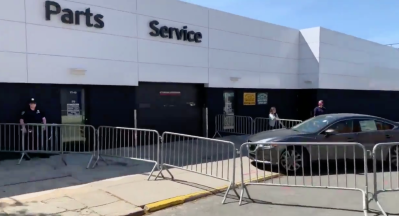CYCLE OF RAGE: Why Does the Parks Dept. Let Drivers Defile Black History?

New York City would never allow people to park on top of its Holocaust memorial. And it would never let people drive on a major civil rights monument. Nor would it let people spew pollution at a national cemetery.
Except that it would.
This week, when the Trump indictment circus rolled (literally) into Lower Manhattan, the NYPD and the Parks Department directed reporters and TV crews to park their personal cars atop the plaza and walkways in Thomas Paine Park and surrounding a monumental sculpture and fountain called “Triumph of the Human Spirit.” At various points this week, there were more than two dozen cars cramming the park.
A defiled park is barely worth mentioning in a city where police and other entitled placard abusers leave their cars in parks, on sidewalks, in front of hydrants, in bus and bike lanes and blocking virtually every roadway in town, except that Thomas Paine Park and “Triumph of the Human Spirit” is not just any defiled park: It’s the defiled burial ground of more than 10,000 African-American slaves and their dependents, which was discovered back in the 1990s and sanctified with a nearby memorial and Lorenzo Pace’s monumental black granite sculpture and fountain.
Pace has been dealing with the desecration of his work almost since it was unveiled in 2000.

“I’ve been complaining about people parking on that plaza for years,” Pace told me the other day. “No other monument like this — which honors the victims of slavery — would be driven on. The African Burial Ground was disrespected from the moment it was rediscovered, and it still is. I guess the mindset can’t be changed overnight, but it would be nice if someone listened to me.”
It shouldn’t take a campaign or a crusading sculptor to get the Parks Department to stop letting people park adjacent to a sacred space and next to a sculpture whose message is about dignity and endurance.
When Pace unveiled his statue two decades ago, it was controversial and widely critiqued; then-Parks Commissioner Henry Stern was said to not like it. But Stern was wrong. Inspired by the Bambaran art of West Africa, the shape evokes both an antelope and an elongated boat, an allusion to the slave trade and, possibly, Native Americans. Besides that universal message, the granite base contains a replica of the lock and key that were used to enslave Pace’s great-great grandfather Steve Pace.
Slavery was legal in New York City until 1827, but the way this plaza is treated is a reminder that forgetting about the city’s history with human bondage remains a semi-official policy: The plaza itself is all cracked due to the weight of heavy cars driving on it whenever there’s an important case in the federal or state courts nearby. The fountain is covered over. There’s garbage everywhere.
“They are mistreating it the whole area,” Pace said. “The parks department should be taking care of it, but they say they don’t have enough money.”
I reached out to the Parks Department, and a spokesperson said that the staff cleans the sculpture “on an annual basis” and the agency is “unaware” of any “adverse issues.”
Here’s a slideshow of the adverse issues:
The Parks Department declined to respond to specific questions about why it even allows drivers to park on the plaza. As such, I decided to imagine what other important New York City landmarks and memorials would look like once car drivers got the idea that they were welcome to store their vehicles there. For instance:





Gersh Kuntzman is editor of Streetsblog. He occasionally writes the Cycle of Rage column, which is archived here.




